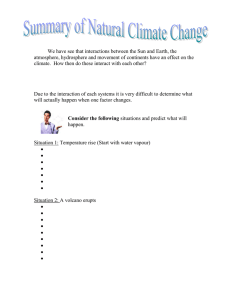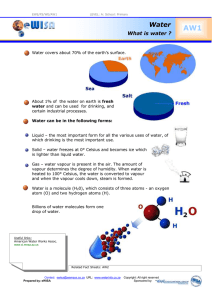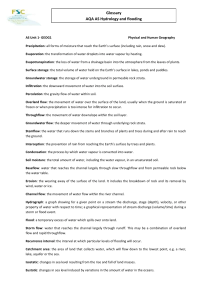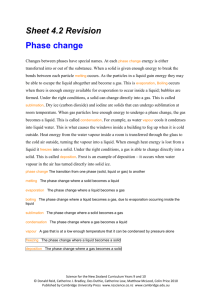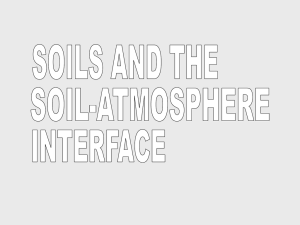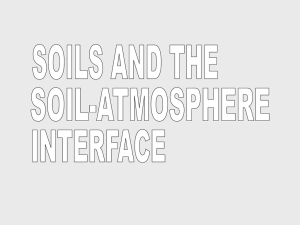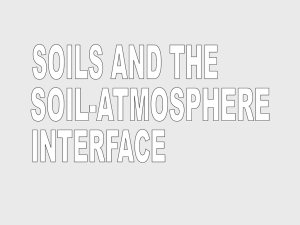Document 16060599
advertisement
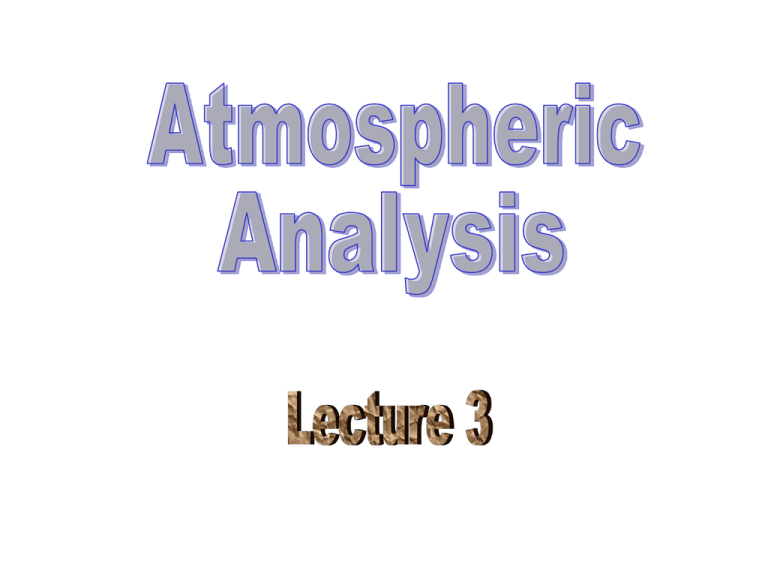
Soil Heat Flux and Soil Temperature Heat transfer within soils is governed by: 1. Thermal conductivity 2. Heat capacity QG = -ks (TS/ z) Where ks is the thermal conductivity * Notice that still air is a poor heat conductor (Table 2.1) Three factors affect ks: 1. Conductivity of soil particles 2. Soil porosity 3. Soil moisture content How does soil moisture affect ks ? • Water increases thermal contact between grains • Water expels air (air has lower thermal conductivity) • Water has much higher heat capacity Thermal diffusivity, Hs Hs = ks/Cs Hs determines the rate of heating due to a given temperature distribution within a substance Hs and soil moisture Hs increases as soils dry because Cs decreases faster than ks Peak values occur in relatively dry soils Very dry soils have low Hs because of the very low thermal conductivity of air High Hs soils have less extreme surface temperature range (eg. saturated clay less extreme than dry peat) Thermal admittance, s A measure of the ease with which a surface may absorb or release heat s = Cs (Hs)1/2 = (ks Cs)1/2 a = Ca (KH)1/2 These properties are important in the transfer of sensible heat between the ground and the atmosphere s/ a = QG/QH Wind (u) and Momentum () Surface elements provide frictional drag Force exerted on surface by air is called shearing stress, (Pa) Air acts as a fluid – sharp decrease in horizontal wind speed, u, near the surface Drag of larger surface elements (eg. trees, buildings) increases depth of boundary layer, zg Vertical gradient of mean wind speed (u/z) greatest over smooth terrain Density of air is ‘constant’ within the surface layer Horizontal momentum increases with height Why ? Windspeeds are higher (momentum u) Examine Figure 2.10b Eddy from above increases velocity ( momentum) Eddy from below decreases velocity ( momentum) Because wind at higher altitudes is faster, there is a net downward flux of momentum = KM(u/z) KM is eddy viscosity (m2/s) - ability of eddies to transfer Friction velocity, u* u* = (/)1/2 Under neutral stability, wind variation with height is as follows: uz = (u*/k) ln (z/z0) where k is von Karman’s constant (~0.40m) and z0 is the roughness length (m) – Table 2.2 Unstable Stable Recall: QH = -CaKH /z ( is potential temperature, accounting for atmospheric pressure changes between two altitudes) Day: negative temperature gradient, QH is positive Night: positive temperature gradient, QH is negative Fluctuations in Sensible Heat Flux •Associated with updrafts (+) and downdrafts (-) •In unstable conditions, QH transfer occurs mainly in bursts during updrafts (Equation above gives a timeaveraged value) Diurnal Surface Temperature Wave Temperature wave migrates upward due to turbulent transfer (QH) Time lag and reduced amplitude at higher elevations The average temperature is also shifted downward Rate of migration dependent on eddy conductivity, KH Water Vapour in the Boundary Layer Vapour Density or Absolute Humidity, v The mass of water vapour in a volume of air (gm-3) Vapour Pressure, e The partial pressure exerted by water vapour molecules in air (0e<5 kPa) e = vRvT where Rv is the specific gas constant for water vapour (461.5 J kg-1 K-1) Alternatively, v=2.17(e/T) ( v in gm-3, e in Pa and T in Kelvin) Saturation Vapour Pressure, e* •Air is saturated with water vapour •Air in a closed system over a pan of water reaches equilibrium where molecules escaping to air are balanced by molecules entering the liquid •Air can hold more water vapour at higher temperatures (See Figure 2.15) •Most of the time, air is not saturated •Vapour Pressure Deficit VPD = e* - e Dew Point / Frost Point The temperature to which a parcel of air must be cooled for saturation to occur (if pressure and e are constant) Recall: Water Vapour Flux E = -KV v/ z Latent Heat Flux QE = -LVKV v/ z (LV is the “latent heat of vaporization”) •Evaporative loss strongest during the day •Evaporative loss may be reversed through condensation (dew formation) •Overall flux is upward (compensates for precipitation) Critical Range of Windspeed for Dewfall Wind too strong: Surface radiative cooling (L*) offset by turbulent warming (QH) Calm conditions: Loss of moisture due to condensation Cannot be replenished and dew formation ceases Ground Fog Formation •Occurs on nights when air approaches saturation point in evening •Surface air develops a strongly negative long-wave radiation budget (emits more than colder surface or air above) •This promotes cooling to dewpoint (fog droplet formation) •Strong flow inhibits fog formation due to turbulent mixing •Fog layer deepens as fog top becomes radiating surface •May linger through day if solar heating insufficient for promotion of convection Bowen Ratio = QH/QE High ratios where water is limited (eg. deserts) or when abnormally cool and moist airmass settles over a region in summer Why ? Solar heating leads to strong temperature gradient Low ratios occur when water is available QE increases, which cools and moistens the airmass
